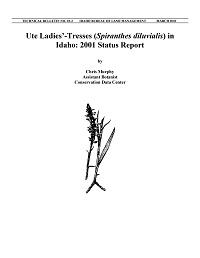Ute Ladies Tresses (Spiranthes diluvialis) in Idaho: 2001 Status Report

The 2001 status report for Ute ladies’-tresses (Spiranthes diluvialis) compliments the previous 1997-2000 status reports and contains new or updated information about the species and its habitat in Idaho. The 1997 status report is the best source for basic distribution and habitat information, as well as for the description and identification of Spiranthes diluvialis. The 1998 status report is the best source for more detailed habitat information of populations on the South Fork Snake River in Idaho. The 1999 status report explains the on-going research on floodplain dynamics in relation to Ute ladies’-tresses habitat. The 2000 status report and this report are primarily focused on current habitat conditions, threats to populations, and the conservation of Spiranthes diluvialis. The same format is used in this update as in previous reports, which should be consulted for information not covered here.
Major findings reported here include:
- Significant expansions of prior known occurrences were discovered at Kelly’s Island (001) and at Black Canyon (022).
- The Conservation Data Center completed a model for predicting the distribution of potential Spiranthes diluvialis habitat on the National Forests of Idaho.
- Vegetation was again monitored at Warm Springs Bottom (003) and Black Canyon (022) to study the influence of floodplain dynamics on succession in Spiranthes diluvialis habitat. No significant vegetation changes could be detected compared with prior years.
- The habitat ecology study, initiated in 1999, relating floodplain dynamics and primary habitat succession to conservation of Ute ladies’-tresses, is on-going and will be completed in 2002.
- 4,133 Ute ladies’-tresses plants were observed in 2001. While the total number of plants observed was a record high, only seven occurrences had higher numbers over last year and seven occurrences have decreased for three or more years in a row. Five occurrences had decreased numbers of plants from last year and three remained the same as in 2000.
- A significant increase in flowering individuals was observed at Annis Island (006), despite a human-ignited wildfire burning a portion of the occurrence during late spring.
- Most occurrences are still threatened by human activities (e.g., cattle grazing, recreation) and/or noxious weed invasion. Habitat at Lufkin Bottom (011) experienced trampling by recreationists. At Mud Creek Bar (009), a trail leading from a boat landing to an unauthorized outfitter camp went directly through occupied habitat. Late-season trespass cattle grazing occurred at Warm Springs Bottom (003). At Falls Campground (004), eight cattle grazed the occurrence prior to the authorized use period (after Labor Day).
- At least 14 occurrences had noxious weeds present within occupied Spiranthes diluvialis habitat. The BLM and USFS released biological control agents to curtail weed invasions.
- A systematic, easily repeatable method for objectively measuring changes and threats to Ute ladies’-tresses habitat was developed, tested, and implemented. Twenty-three permanent monitoring transects were established. The data provides a reference point for measuring future environmental change at multiple scales. An index of habitat change was used involving the measurement of important Spiranthes habitat attributes.
